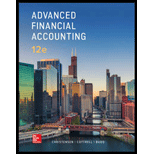
Concept explainers
a
Introduction: When asset held by the subsidiary are with differential, both the equity method income and consolidated net income is affected, as the proportion of differential is included in parents books as part of the investment in the subsidiary; when the asset is sold it must be written off by a parent, in consolidation.
The entries recorded during 20X5 with respect to investment in S.
a
Explanation of Solution
Entries related to investment in subsidiary
| particulars | Debit $ | Credit $ |
| Investment in S Inc. | 864,000 | |
| Cash | 864,000 | |
| (Initial investment in S Inc. recognized) | ||
| Investment in S Inc. | 135,000 | |
| Income from S Inc. | 135,000 | |
| (Controlling interest in S income for 20X5 recorded) | ||
| Income from S Inc. | 82,350 | |
| Investment in S Inc. | 82,350 | |
| (Amortization of excess acquisition price recognized) |
- Initial investment in S recorded
- Income from subsidiary S recognized
- Amortization of excess acquisition price Excess differential calculation
| Differential on Inventory | $5,000 |
| Excess value of land | $75,000 |
| Differential on notes payable | $7,500 |
| $4,000 | |
| Excess value | $91,500 |
Amortization of excess acquisition debited to income from S and Credited to investment in S Inc.
b
Introduction: When asset held by the subsidiary are with differential, both the equity method income and consolidated net income is affected, as the proportion of differential is included in parents books as part of the investment in the subsidiary; when the asset is sold it must be written off by a parent, in consolidation.
The consolidation entries for the year 20X5.
b
Explanation of Solution
| Particulars | Debit $ | Credit $ |
| Common stock | 500,000 | |
| Premium on common stock | 100,000 | |
| 120,000 | ||
| Income from S Inc. | 135,000 | |
| Non-controlling interest in net income of S | 15,000 | |
| Investment in S Inc. | 783,000 | |
| Non-controlling interest in net assets of S | 87,000 | |
| (Elimination of beginning investment in S) | ||
| Cost of goods sold | 5,000 | |
| Gain on sale of land | 75,000 | |
| Interest expense | 7,500 | |
| Depreciation expense | 4,000 | |
| Income from S Inc. | 82,350 | |
| Non-controlling interest in net income of S | 9,150 | |
| (Amortization of excess value into income of subsidiary) | ||
| Equipment | 60,000 | |
| Discount on note payable | 42,500 | |
| 50,000 | ||
| | 4,000 | |
| Investment in S Inc. | 133,650 | |
| Non-controlling interest in net assets of S | 14,850 | |
| (Reclassification and recognition of excess value) |
- Elimination of beginning investment in S
- Amortization of excess value in net income of subsidiary Excess differential calculation
- Reclassification of excess value in net assets
| Differential on Inventory assigned to cost of sale | $5,000 |
| Excess value of land( gain on sale of land) | $75,000 |
| Interest expense | $7,500 |
| Depreciation | $4,000 |
| Excess value | $91,500 |
Amortization of excess acquisition debited to income from S and Credited to investment in S Inc.
Computation of goodwill:
| Differential given | $240,000 |
| Less: Excess on inventory | ($5,000) |
| Land | (75,000) |
| Equipment | (60,000) |
| Discount on note payable | (50,000) |
| Goodwill | $50,000 |
Amount credited to Investment in S
Want to see more full solutions like this?
Chapter 5 Solutions
Advanced Financial Accounting
- Please give me correct answer this financial accounting questionarrow_forwardInternal control in a business organization and the reporting of cash on the balance sheet as well as managing receivables and estimating uncollectible accounts is important. What is internal control, and what are the objectives of a well-designed internal control structure in an organization?arrow_forwardCan you please solve this accounting problem?arrow_forward
- I am looking for a step-by-step explanation of this financial accounting problem with correct standards.arrow_forwardI need help with this general accounting question using standard accounting techniques.arrow_forwardCan you help me solve this general accounting problem with the correct methodology?arrow_forward

 AccountingAccountingISBN:9781337272094Author:WARREN, Carl S., Reeve, James M., Duchac, Jonathan E.Publisher:Cengage Learning,
AccountingAccountingISBN:9781337272094Author:WARREN, Carl S., Reeve, James M., Duchac, Jonathan E.Publisher:Cengage Learning, Accounting Information SystemsAccountingISBN:9781337619202Author:Hall, James A.Publisher:Cengage Learning,
Accounting Information SystemsAccountingISBN:9781337619202Author:Hall, James A.Publisher:Cengage Learning, Horngren's Cost Accounting: A Managerial Emphasis...AccountingISBN:9780134475585Author:Srikant M. Datar, Madhav V. RajanPublisher:PEARSON
Horngren's Cost Accounting: A Managerial Emphasis...AccountingISBN:9780134475585Author:Srikant M. Datar, Madhav V. RajanPublisher:PEARSON Intermediate AccountingAccountingISBN:9781259722660Author:J. David Spiceland, Mark W. Nelson, Wayne M ThomasPublisher:McGraw-Hill Education
Intermediate AccountingAccountingISBN:9781259722660Author:J. David Spiceland, Mark W. Nelson, Wayne M ThomasPublisher:McGraw-Hill Education Financial and Managerial AccountingAccountingISBN:9781259726705Author:John J Wild, Ken W. Shaw, Barbara Chiappetta Fundamental Accounting PrinciplesPublisher:McGraw-Hill Education
Financial and Managerial AccountingAccountingISBN:9781259726705Author:John J Wild, Ken W. Shaw, Barbara Chiappetta Fundamental Accounting PrinciplesPublisher:McGraw-Hill Education





